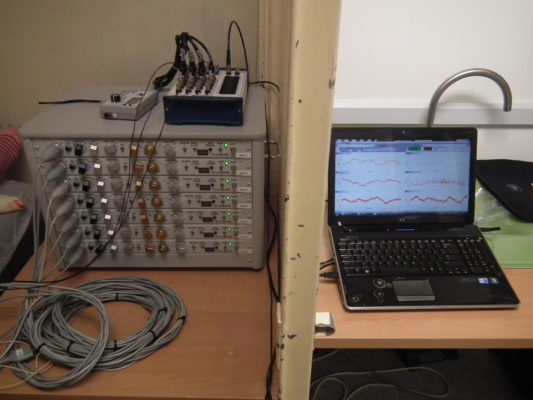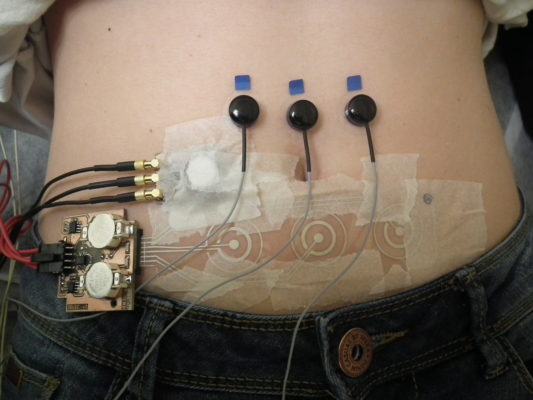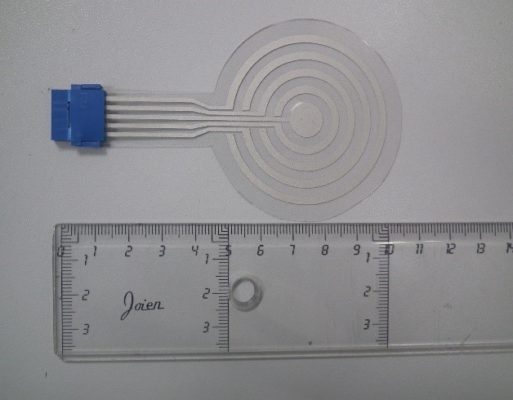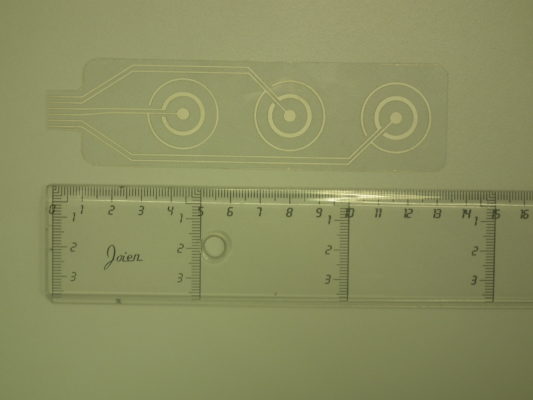Monitoring & analysis of intestinal myoelectrical signals.
Desarrollo, caracterización y experimentación de un sensor laplaciano activo para la monitorización incruenta de la actividad gastrointestinal (TEC2007-64278/TCM)
Aplicación de Técnicas Laplaciana para la Monitorización de la Actividad Eléctrica del Músculo Liso Humano. Énfasis en Electrohisterograma (TEC2010-16945/TCM)
The electroenterogram (EEnG) is the record of the myoelectric activity of the small intestine. It has two components: the slow wave (SW) and the spike bursts (SB). The SW is associated to the slow and periodic oscillations of basal signal. It is the pacemaker of the intestine and determines the maximum frequency of intestinal contractions associated to the SB. The frequency of the SW varies along the small intestine, from around 12 cycles per minute (cpm) in the duodenum to 9 and 11 cpm in the jejunum and about 8 cpm in the ileum. Although abnormal SW patterns are related with diabetes and several intestinal pathologies, such as mechanical intestinal obstruction, irritable bowel syndrome, paralytic ileus, and intestinal ischemia, surface EEnG recording is not yet used in clinical practice. One of the main reasons for this it is the poor quality of surface signals.
Usually, these recordings are made with conventional disc electrodes. However, this yields a poor spatial resolution, caused in part by the blurring effect due to different conductivities of the volume conductor. The Laplacian potential has been demonstrated to reduce this effect, providing a better spatial resolution. Surface Laplacian potentials can be estimated by applying discretization techniques and combining the surface potentials picked up by a set monopolar electrodes, or using concentric ring electrodes of different sizes and configurations (bipolar, tripolar, tripolar connected in bipolar configuration)
In this project it was aimed to improve the recording of EEnG signals by developing concentric ring electrodes and to characterize EEnG signals for the identification of intestinal SW.
- Different versions of multipole concentric ring electrode that permits to perform simultaneous records with different ring sizes and configuration (monopolar, bipolar, tripolar…) were So as to facilitate its clinical use, improving its contact with the body surface and comfort, it was implemented onto a flexible substrate and incorporated an adhesive layer and a single output connector. The electrode was manufactured by means of screen printing technology.
This electrode permits to study the best signal-sensing arrangement for each surface bioelectrical recording application. Specifically, the effect of electrode location, adhesive material, configuration and ring size on different signal quality and intestinal SW detection capability parameters derived from surface EEnG recordings was evaluated.
- Regarding electrode location, subumbilical position is preferred. Supraumbilical position is more affected by the respiratory and cardiac interference.
- As for the material used for electrode fixation the adhesive material presented better behavior in terms of robustness to respiratory and low frequency interferences.
- With respect to the configuration of the signal recording, BC proved to be better than MC in terms of attenuation of respiratory and cardiac interference. On the other hand, it has been found that low frequency interference affects the EEnG signals in BC configuration more than in MC
All in all, it was found that when considering all parameters in a global approach the best combination of factors was of bipolar concentric configuration with adhesive material and subumbilical position.
- Regarding the nfluence of the ring size, it was observed that the larger the ring size the less the influence of low frequency interferences. On the other hand, the influence of respiratory interference on the EEnG record is greater with increasing ring size. The best results in terms of intestinal SW identification and global signal quality were obtained with the ring of 30 mm in outside diameter, which reaches a balance of previously indicated factors.
- Regarding the comparison of signals picked up with the multi-CRE and conventional bipolar recording with disc electrodes. Bipolar concentric records presented greater attenuation of cardiac interference. This behaviour could be mainly attributed to the enhanced spatial resolution of bipolar concentric electrodes, which are more sensitive to the activity of dipole sources in the area near the electrode and less sensitive to distant dipoles such as those of cardiac origin. On the other hand, BC electrodes also attenuates the influence of respiratory interference in comparison to conventional bipolar records. This is probably due to a more homogeneous movement of the central disc and the outer ring integrated on a single electrode, than that of the two independent disc electrodes used for conventional bipolar records. Nonetheless, this latter outperforms results of BC in terms of influence of low frequency interferences. All in all, the capability to identify the SW frequency and provide surface EEnG signals of better quality was better for recordings performed with the multi-CRE developed.










